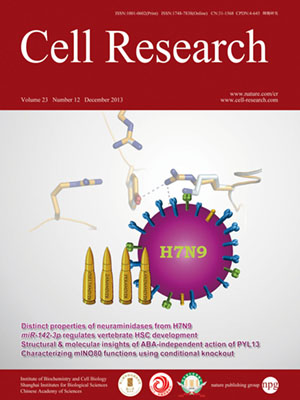
Volume 23, No 12, Dec 2013
ISSN: 1001-0602
EISSN: 1748-7838 2018
impact factor 17.848*
(Clarivate Analytics, 2019)
Volume 23 Issue 12, December 2013: 1380-1395
ORIGINAL ARTICLE
The unique mode of action of a divergent member of the ABA-receptor protein family in ABA and stress signaling
Yang Zhao1,2,*, Zhulong Chan1,3,*, Lu Xing2,4, Xiaodong Liu1, Yueh-Ju Hou2, Viswanathan Chinnusamy2,5, Pengcheng Wang2, Chengguo Duan2 and Jian-Kang Zhu1,2
1Shanghai Center for Plant Stress Biology and Shanghai Institute of Plant Physiology and Ecology, Shanghai Institutes of Biological Sciences, Chinese Academy of Sciences, Shanghai 200032, China
2Department of Horticulture and Landscape Architecture, Purdue University, West Lafayette, IN 47906, USA
3Key Laboratory of Plant Germplasm Enhancement and Specialty Agriculture, Wuhan Botanical Garden, Chinese Academy of Sciences, Wuhan, Hubei 430074, China
4School of Life Sciences, University of Science and Technology of China, Hefei, Anhui 230026, China
5Division of Plant Physiology, Indian Agricultural Research Institute, New Delhi 110012, India
Correspondence: Jian-Kang Zhu,(jkzhu@purdue.edu)
Proteins in the PYR/PYL/RCAR family (PYLs) are known as receptors for the phytohormone ABA. Upon ABA binding, PYL adopts a conformation that allows it to interact with and inhibit clade A protein phosphatase 2Cs (PP2Cs), which are known as the co-receptors for ABA. Inhibition of the PP2Cs then leads to the activation of the SnRK2 family protein kinases that phosphorylate and activate downstream effectors in ABA response pathways. The PYL family has 14 members in Arabidopsis, 13 of which have been demonstrated to function as ABA receptors. The function of PYL13, a divergent member of the family, has been enigmatic. We report here that PYL13 differs from the other PYLs in three key residues that affect ABA perception, and mutations in these three residues can convert PYL13 into a partially functional ABA receptor. Transgenic plants overexpressing PYL13 show increased ABA sensitivity in seed germination and postgermination seedling establishment as well as decreased stomatal conductance, increased water-use efficiency, accelerated stress-responsive gene expression, and enhanced drought resistance. pyl13 mutant plants are less sensitive to ABA inhibition of postgermination seedling establishment. PYL13 interacts with and inhibits some members of clade A PP2Cs (PP2CA in particular) in an ABA-independent manner. PYL13 also interacts with the other PYLs and antagonizes their function as ABA receptors. Our results show that PYL13 is not an ABA receptor but can modulate the ABA pathway by interacting with and inhibiting both the PYL receptors and the PP2C co-receptors.
10.1038/cr.2013.149
FULL TEXT | PDF
Browse 2472


